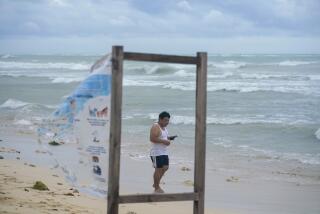Yucatan weathers Dean’s fury
- Share via
FELIPE CARRILLO PUERTO, MEXICO — Nature, good luck and good planning all combined Tuesday to deliver what the people of the Yucatan Peninsula called a miracle.
Hurricane Dean, packing 165-mph winds, was a Category 5 storm when it made landfall near this town of 20,000 people early Tuesday. And it remained a “monster” as it crossed the peninsula, causing widespread destruction.
But there appeared to be few injuries. And as of late Tuesday, no deaths had been reported, despite the fierce winds that caused heavy damage to more than one-third of the buildings in some seaside communities.
“They’ve made an effort here to spread the idea of being prepared,” said Abel Posadas, part of a team of Red Cross workers who had driven 1,000 miles from Mexico City to Felipe Carrillo Puerto in the days before the hurricane struck.
“Everyone just stays calm and gets ready.”
About 1,500 families saw their homes destroyed or heavily damaged in Quintana Roo state, which includes Felipe Carrillo Puerto and resorts such as Cancun, officials said.
Many of those rendered homeless are the state’s poorest residents, including hundreds of Maya Indians.
Humberto Sosa, 35, a Maya-speaking resident of Felipe Carrillo Puerto, was one of those who lost his home. Like many in the region, it was a flimsy structure of cardboard and tin sheets.
“When those tin sheets start flying, they’re really dangerous because they’re sharp,” he said. “You have to get away.” He escaped injury by seeking refuge in a city shelter.
In previous years, Sosa and other poor residents of the region were more likely to try to ride out the storm. There were reports of residents of Maya communities ignoring evacuation orders for this storm also, and officials said it would take days to learn the fate of the most isolated areas.
But with the memory still fresh of 2005’s Hurricane Wilma, which caused widespread destruction in Cancun, officials had redoubled their education efforts.
“We’ve spent days talking to our Mayan brothers, telling them to come to the shelters in the city,” said Fernando Montalvo Rodriguez, a government official in the region. Many live in remote communities where Spanish is a second language.
“We told them to think of the trip here as a vacation,” he added.
Similar preparations were made in Cancun and other coastal cities and towns that attract high numbers of tourists.
In Tulum, about 60 miles north of Felipe Carrillo Puerto, officials evacuated a 10-mile stretch of beach outside the city, where hotels and bungalows face pristine white sands and the turquoise Caribbean.
A third of the buildings along the beach sustained heavy damage, officials said.
Tulum emergency coordinator Lucio Salvador Arguea credited the government’s year-round education efforts, which include PowerPoint presentations on “storm surges” at local schools.
“People here know that when the army and the municipal government comes and tells them to leave, they have to go,” he said.
When a reporter drove along the beachside road Monday, about 18 hours before the storm made landfall, he found nearly all of the buildings there padlocked and empty.
Dean also wiped out a mile-long stretch of the dirt road that links Tulum to Punta Allen, a village of 600 people that sits at the entrance to a bay. But no rescue effort was necessary -- all of the residents had been evacuated a day earlier.
The eye of the storm passed through sparsely populated nature reserves and jungles between this city and Chetumal, a stroke of good fortune that some attributed to an act of God and nature.
“There was a cold front off Cuba,” said Montalvo Rodriguez. “At the last minute, it pushed the eye away from us, and away from Chetumal.”
Fallen trees littered the 90-mile road that links Chetumal and Felipe Carrillo Puerto. But the mangrove swamps and tropical forests that cover much of the region acted like a huge pillow that absorbed Dean’s punch.
Chetumal, the capital of Quintana Roo state and home to 147,000 people, was the city hardest hit by the storm. There was extensive flooding in the city center.
Hundreds of trees and light poles were felled in the city, an official said. But otherwise, the infrastructure appeared to have suffered no serious damage.
U.S. forecasters said Hurricane Dean was the third-most intense Atlantic hurricane to make landfall since record-keeping began in the mid-19th century.
The only recorded storms that were stronger when they hit land were a 1935 Labor Day hurricane that hit the Florida Keys, and Hurricane Gilbert, which hit Cancun in 1988.
Later Tuesday, the storm worked its way west over the peninsula, weakening to a Category 2 as it passed through the state of Campeche and into the Gulf of Mexico, where it could threaten offshore platforms that produce much of Mexico’s oil.
Dean was expected to regain some strength over the Gulf of Mexico before again hitting the Mexican coast. Its second landfall is expected to come today between Tampico and Veracruz.
Mexican President Felipe Calderon cut short his summit in Ottawa with President Bush and Canadian Prime Minister Stephen Harper to travel to the area late Tuesday and survey the damage.
“I am worried, very worried, that the hurricane passed over some of our poorest Mayan communities in the Yucatan,” Calderon said before leaving Ottawa.
Juan Bautista Ucan, 47, said several ramshackle homes in his neighborhood in Felipe Carrillo Puerto were destroyed, including his own.
“We tied everything up, but it didn’t help,” he said, describing the 12 hours of fierce winds that succeeded in knocking down his wooden house. “The only thing left is the skeleton.”
--
Cecilia Sánchez of The Times’ Mexico City Bureau contributed to this report.
More to Read
Sign up for Essential California
The most important California stories and recommendations in your inbox every morning.
You may occasionally receive promotional content from the Los Angeles Times.











